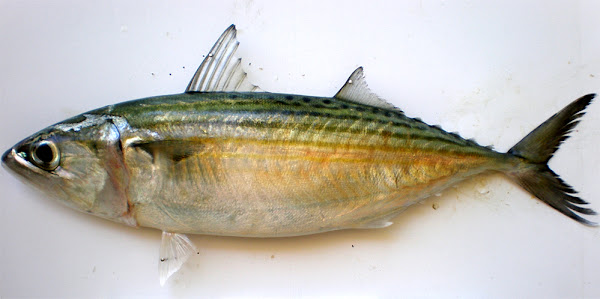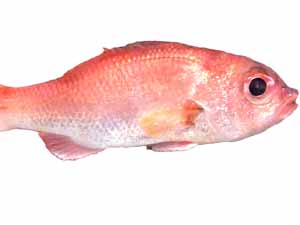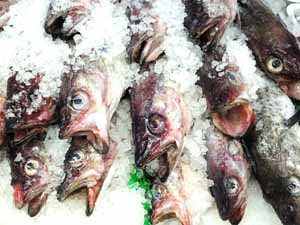The Indian Mackerel fish is a species of mackerel which is mainly found in the Indian and West Pacific oceans, and their surrounding seas.
It is very important as food fish, and is commonly used in South and South-East Asian cuisine. It is also known by many other different names such as Kembung, Bangda, Aiyla, Aiyla Meen, Bangude etc.
Currently the Indian Mackerel fish is widespread in the Indo-West Pacific from South Africa, Seychelles and Red Sea east through Indonesia and off northern Australia to Melanesia, Micronesia, Samoa, China and the Ryukyu Islands.
And the fish is also found in the Mediterranean Sea. It has entered to the eastern Mediterranean Sea through the Suez Canal. However, read some more information about this fish species below.
Indian Mackerel Fish Characteristics
The Indian Mackerel fish has moderately deep body. The head is longer than the body depth. The maxilla are partly concealed, covered by the lacrimal bone (but extend till around the hind margin of the eye).
They have thin dark longtitudinal bands on the upper part of their body, which may be golden on fresh specimens. And there is also a black spot on the body near the lower margin of the pectoral fin.
Their caudal and pectoral fins are yellowish, and the dorsal fins are yellowish with black tips. And the remaining fins of the Indian Mackerel fish are dusky.
Average body length of the Indian Mackerel fish is around 25 cm. But they can reach a maximum of 35 cm total body length. Photo and info from [1].

Habitat and Distribution
Indian Mackerel fish is primarily found in the warm waters of the Indian Ocean, the Bay of Bengal, and the Arabian Sea. It is a highly migratory fish species that travels long distances in search of food and suitable breeding grounds.
During the monsoon season, Indian Mackerel fish move closer to the shore to spawn, making them easier to catch for fishermen.
Food Habits
Indian Mackerel fish is a carnivorous species that feeds on small fish, crustaceans, and plankton. It is an opportunistic feeder and can adapt its feeding habits according to the availability of prey.
The Indian Mackerel fish’s diet affects its taste and texture, which can vary depending on the type of food it has consumed.
Nutritional Value
Indian Mackerel fish is a rich source of several essential nutrients, including omega-3 fatty acids, protein, vitamins B12 and D, and minerals such as selenium and phosphorus.
Consuming Indian Mackerel fish regularly can help improve brain function, reduce inflammation, lower the risk of heart disease, and boost overall health.
Preparation and Cooking
Indian Mackerel fish is easy to prepare and cook, making it a popular choice among seafood lovers. The most common methods of cooking Indian Mackerel fish include grilling, frying, baking, and steaming.
Its meat is tender, flaky, and flavorful, with a mild to moderate fishy taste depending on the freshness of the fish.
Health Benefits
Consuming Indian Mackerel fish regularly offers several health benefits. It is an excellent source of omega-3 fatty acids, which are essential for maintaining healthy brain function, reducing inflammation, and lowering the risk of heart disease.
Omega-3 fatty acids also play a crucial role in improving eye health, reducing the risk of depression and anxiety, and promoting healthy skin.
Indian Mackerel fish is also a good source of protein, which is essential for building and repairing tissues in the body. Its high protein content makes it an ideal food choice for athletes and people looking to build muscle mass.
Breeding
Spawning season of the Indian Mackerel fish is between March and September in the northern hemisphere. But it is between September and the following March around Seychelles in the southern hemisphere.
Spawning of these fish generally occurs in batches. The females lay eggs, and the eggs are fertilized externally. The egg are left to develop on their own, and the eggs are not guarded by the males or females.
Uses
The Indian Mackerel fish is mainly used for food.
Special Notes
The Indian Mackerel fish are generally found in the shallow, coastal waters, where the surface water temperature is at least 17 °C.
The mature fish are generally found in the coastal bays, harbours and in the deep lagoons. They are also generally found in the turbid waters rich in plankton.
It is also widely found in Karnataka costal belt, and is a very popular food fish in Kudla. Currently the fish is used mainly for food.
It is marketed fresh, frozen, canned, dried-salted and also made into fish sauce. However, review full breed profile of this fish in the table below.
| Name | Indian Mackerel |
| Kingdom | Animalia |
| Phylum | Chordata |
| Class | Actinopterygii |
| Order | Perciformes |
| Family | Scombridae |
| Genus | Rastrelliger |
| Species | R. kanagurta |
| Binomial Name | Rastrelliger kanagurta |
| Other Names | Also known as Kembung, Bangda, Aiyla, Aiyla Meen, Bangude etc. |
| Breed Purpose | Mainly food |
| Special Notes | Commercially important fish species, mainly used for food, marketed fresh, frozen, canned, dried-salted and also made into fish sauce |
| Breeding Method | Natural |
| Climate Tolerance | Native climates |
| Body Color | Narrow dark longitudinal bands on upper part of body and a black spot on body near lower margin of pectoral fin; dorsal fins yellowish with black tips, caudal and pectoral fins yellowish; other fins dusky |
| Rarity | Common |
| Availability | Asia |






